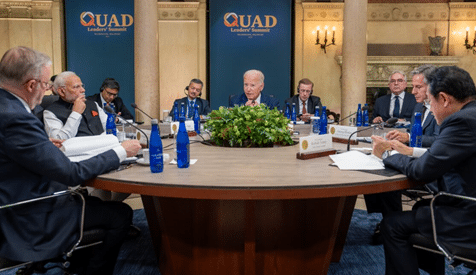India, still a developing nation, has yet to match the defense and economic strength of countries like the USA, Japan, and Australia. Despite this, India is part of the Quadrilateral Security Dialogue (QUAD), which positions it alongside them. The QUAD, initiated in 2007 by Japan’s former PM Shinzo Abe, was designed as a multilateral dialogue for strategic security in the Indo-Pacific region, with the inclusion of India being an important addition to balance China’s growing influence in the area.
The first virtual QUAD summit was held in March 2021, bringing together leaders from the USA, Japan, Australia, and India. The primary focus was on fostering cooperation to ensure regional stability and peace in the Indo-Pacific, as well as addressing global concerns like climate change, health challenges, and technological advancement.
The 2024 QUAD summit highlighted the growing importance of this alliance in maintaining Indo-Pacific security and stability. While its mission is framed as one of peace and cooperation, the underlying strategic objective is clear: to present a united front against China’s expanding influence. How the QUAD evolves in the coming years will largely depend on how well it can balance these dual roles of peacekeeper and power broker in a rapidly changing global landscape
Fast forward to September 21, when the QUAD leaders met in Wilmington, Delaware, for the 6th summit. US President Joe Biden, Australian PM Anthony Albanese, Japanese PM Kishida Fumio, and Indian PM Narendra Modi gathered to reaffirm their commitment to a free and open Indo-Pacific. The summit also marked the second in-person meeting, a clear signal of the growing significance of this alliance. While the QUAD is officially seen as a coalition for regional security and economic cooperation, many analysts question whether its true purpose lies in countering China’s rising power.
During the summit, the leaders discussed a wide array of topics, from economic collaboration to defense cooperation, all with the underlying objective of maintaining peace in the Indo-Pacific region. The declarations issued at the summit included plans to enhance maritime security, prepare for natural disasters, and build resilient infrastructure in member states. They also discussed investing in cutting-edge technologies, strengthening cybersecurity, and boosting cooperation in addressing global challenges such as climate change.
An important aspect was the recognition of the need for stronger defense cooperation, although the leaders were careful not to overtly mention military alliances. Instead, the emphasis was on strategic dialogue and shared values, underscoring the importance of stability in the region. This focus on non-military issues, however, does not mask the fact that the QUAD has been, and continues to be, viewed as a counterbalance to China’s influence in the Pacific, Southeast Asia, and the Indian Ocean.
India’s role in the QUAD is particularly significant. Despite its economic and military gaps in comparison to the USA, Japan, and Australia, It has emerged as a key partner due to its strategic position and growing regional influence. India has long-standing territorial disputes with China, making it a natural ally for countries looking to curb it. The USA and its allies have also pledged support to India in its border disputes with China, further solidifying the country’s role in the alliance.
What makes India’s inclusion in the QUAD intriguing is the country’s developing status. It is far from being an economic powerhouse like the USA or Japan, and its military capabilities, while substantial, are not on par with those of its QUAD counterparts. Yet, India’s importance to the group cannot be understated. As the world’s most populous country and a regional giant, India’s involvement in the QUAD is crucial in any effort to counterbalance China’s rise.
The summit also revealed plans to strengthen economic cooperation among the QUAD members. The first-ever meeting of QUAD Commerce and Industry Ministers is scheduled in the coming months, aimed at fostering mutual trade, enhancing industrial ties, and promoting economic growth. This focus on trade and industry reflects a long-term strategy to create deeper economic interdependencies that can act as a buffer against potential conflicts or rivalries.
Furthermore, the QUAD members have committed to increasing funding for key projects in the Indo-Pacific region through their respective national budgets. This financial commitment is seen as a way to ensure the lasting impact of QUAD initiatives, ranging from health care improvements to infrastructure development. The establishment of QUAD Financial Development Institutions, which aim to drive investments in clean energy, food security, and quality infrastructure, was also welcomed by the leaders.
The shadow of China loomed large over the discussions. While the official language of the meeting was one of peace, cooperation, and shared prosperity, many analysts believe that the real goal of the QUAD is to contain China’s growing influence. The timing of the summit is noteworthy, as tensions continue to rise globally, particularly with the ongoing Russia-Ukraine war and the recent escalation in the Middle East between Israel and Lebanon. During the summit, Israel launched a brutal attack on Lebanon, killing more than 500 civilians. Interestingly, this major global event received no mention during the summit, further fuelling speculation that the QUAD’s focus is singularly fixed on countering China rather than addressing broader global crises.
In terms of military power, the USA, Japan, and Australia are undeniably stronger than India. However, India’s geographic and political significance, combined with its large population, makes it a pivotal player. The alliance appears to be designed not only to promote regional security but also to strategically position India as a counterweight to China in the Indo-Pacific. This is especially important given India’s ongoing border disputes with China and its desire to challenge China’s dominance in the region.
While the official statements from the Wilmington summit emphasize peace and cooperation, it is clear that the QUAD is becoming a more structured and formalized alliance. The regularity of meetings, the institutionalization of QUAD processes across various departments and agencies in member states, and the focus on long-term cooperation suggest that the QUAD is positioning itself for a sustained role in shaping the future of the Indo-Pacific region.
However, questions remain about whether the QUAD can achieve its ambitious goals without triggering greater tensions with China. As the alliance deepens its economic and defense ties, it risks being perceived not just as a coalition for peace, but as a strategic power bloc aimed at curbing China’s rise. India, as the least developed of the four members, will need to navigate this complex geopolitical landscape carefully, balancing its own regional interests with the broader goals of the QUAD.
The 2024 QUAD summit highlighted the growing importance of this alliance in maintaining Indo-Pacific security and stability. While its mission is framed as one of peace and cooperation, the underlying strategic objective is clear: to present a united front against China’s expanding influence. How the QUAD evolves in the coming years will largely depend on how well it can balance these dual roles of peacekeeper and power broker in a rapidly changing global landscape.























